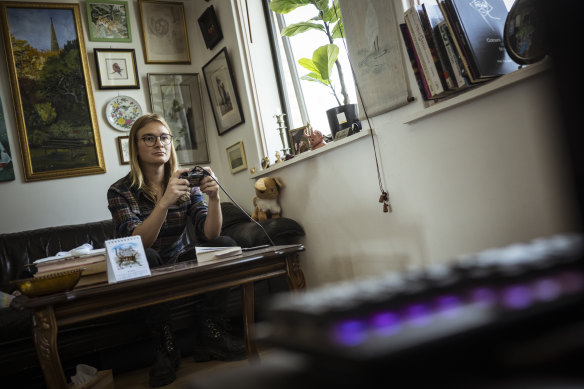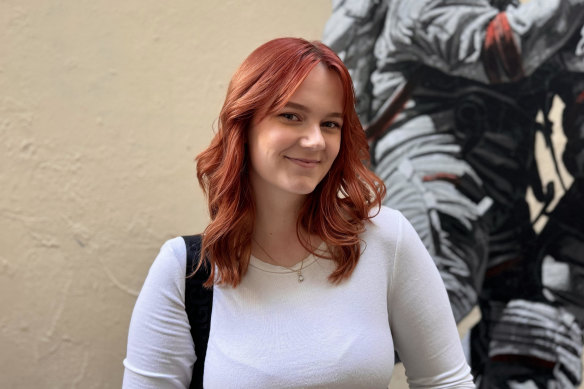This was published 4 months ago
Female and LGBTQ gamers face constant abuse. For many, it’s enough to give up playing
By Nell Geraets
For a long time, video games provided a refuge for Simone Anders, an escape from the isolation she sometimes felt in the real world. Over time, however, this refuge began to crumble.
Today, many of Anders’ favourite games, including Overwatch and Valorant, are riddled with insulting slurs, making people like them – a trans woman – feel far from welcome.

Simone Anders stopped playing multiplayer games altogether because of rampant online harassment.Credit: Chris Hopkins
“It’s very commonplace to see an aggressive use of slurs, often unprompted,” Anders, 27, says. “If you reveal you’re not male, not cis[gender], you hear a wide array of slurs. You’d also often immediately hear a change to aggressively sexual phrasing.”
Most verbal harassment is met with silence from other players, Anders says, either out of fear of becoming the target themselves, or because of the sheer volume of insults gamers hear daily.
As a result, Anders now avoids multiplayer games altogether. “It just became too much. People got really invasive. They would find my username and send me really gross messages privately,” she says.
“As a trans person, living is already a kind of activism, a living resistance ... I still game, but I don’t use those [multiplayer] spaces because I find it exhausting. You can deal with it for a while, but eventually, it just piles up.”
According to a recent report by consulting firm Bastion Insights, which surveyed 601 Australian gamers aged 16 and over, LGBTQ and female players were most likely to face harassment, with 92 per cent of LGBTQ and 83 per cent of female players having experienced or observed some kind of abuse while gaming.
Notably, rates of harassment were also high for male-identifying gamers, with 72 per cent having seen or experienced abuse. However, the specific type of harassment often differed. According to the report, male players were more likely to experience racial harassment, while female and LGBTQ players faced higher rates of gender-based or sexual discrimination.
So why is harassment so common in these online spaces, and why are female-identifying and LGBTQ players more frequently targeted?
Much of it comes down to how gaming audiences have changed says UNSW associate professor Michael Kasumovic, who has researched gender differences in video games. Video games were once largely the realm of men, he says, a space in which they could feel power and control. However, games have since been developed with diverse storytelling and broader audiences in mind.

First-person shooter games like Call of Duty tend to be rife with harassment.Credit: Activision
“When people feel like they’re losing power, they tend to feel very upset,” Kasumovic says. “The best way to keep someone out of the group is to make sure they don’t feel welcome. And the easiest way to make someone feel unwelcome is to harass them and make them want to leave.”
Advertising has exacerbated this problem says University of Sydney digital cultures lecturer Dr Mark Johnson. Though the industry has become more diverse in the past few decades, gaming has been largely marketed as a space for young white males, arguably encouraging them to feel a degree of ownership.
Harassment is generally most common in first-shooter multiplayer games like Counter-Strike or Call of Duty, Kasumovic adds, in which competitive social hierarchies form. It has been occurring for a few decades now, one of the most notable examples being Gamergate, a harassment campaign that took place between 2014 and 2015 over the changing face of gaming culture.
As life increasingly shifts online, it’s becoming easier for those who object to diversity in gaming to organise and coordinate these kinds of campaigns, Johnson says. “Online, people are generally anonymous, making them far more inclined to feel comfortable being obnoxious.”
Maddy, a 22-year-old gamer who goes by Phos online, says bullying and harassment during gameplay is a daily occurrence. “It’s not only tolerated, it’s a widely accepted practice within the gaming community.”
Maddy says this abuse can entail anything from female gamers being told to “get back in the kitchen” to more targeted sexist, homophobic and transphobic insults.
In an attempt to reduce this, Maddy limits her use of voice chat. However, when she does use it, the derogatory language tends to increase, with some teammates even leaving a game simply because they’ve realised they’re playing with a woman.
“I’ve had to take numerous breaks from the games I enjoy because the insults and derogatory language impact my self-esteem and, to put it mildly, make me feel like a worthless human being simply because of my gender.”

Maddy, aka Phos, says online harassment is a daily occurrence.
Despite the serious impact harassment can have on players, many game developers remain relatively “hands-off” in terms of moderation, Johnson says.
“Their bottom line is profitability and profitability comes from maximising the size and the engagement of their player base. Most major blockbuster games could hugely improve their moderation, but it costs money.”
Anders agrees, noting that many games tend to merely “obstruct” players from certain parts of the game rather than ban them. “The action taken is performative in a lot of ways.”
To improve these systems, Jackie Hallan, interim chief executive of ReachOut, says tech companies need to work directly with young people during development.
“The creators of these games have access to sophisticated technology, so this is about designing safe spaces in the first place with and for young people. It’s also about providing young people with easy ways to access support if they need it.”
It must also go beyond the games themselves. Social initiatives, such as ACMI’s female and non-binary gamer club have already helped people like Anders rediscover joy in games in a safe, tolerant environment.
ACMI’s director of programming Emily Sexton says the club, which began in 2018, now has about 300 members.
“It’s a low-key, very friendly space,” Sexton says. “Video games unlock creativity and collaboration in a way few other cultural forms can ... When women and LGBTIQA+ people feel they have to retreat from those spaces, and aren’t supported to resist and persist on a structural level, our collective imagination and futures will become much poorer.”
There is also value in campaigns involving industries outside of gaming, Kasumovic says. Beauty company Maybelline New York recently launched a campaign to raise awareness of online harassment against female and LGBTQ gamers.
According to experts, these kinds of initiatives encourage a wider array of people to reflect on the issue and push for change.
Perhaps the most important step in this push for change, however, will be regaining the trust of female and LGBTQ players who were made to feel unwelcome for so long.
“I just have the assumption now that in most games I’m going to find a phrase or word that’s going to ruin my experience,” Anders says. “If I’m guaranteed to find that sort of thing every time, then I may as well play single-player games for the rest of my life.”
Make the most of your health, relationships, fitness and nutrition with our Live Well newsletter. Get it in your inbox every Monday.